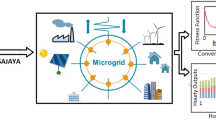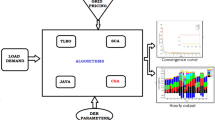Abstract
In recent years, energy management (EM) has become a vital tool for the planning of various energy sources in the microgrid. The EM scheme helps in the effective planning of various energy sources so that a proper balance between generation and load demand can be maintained. In this aspect, different management schemes have been developed to effectively plan various sources. In this work an interactive class topper optimization (I-CTO) based energy management scheme for an interconnected microgrid considering renewable energy sources, battery storage systems, demand side management, etc. is presented. The proposed scheme aims to optimally plan different energy sources in the microgrid so that the generation and emission cost may be minimized. To achieve this objective of having an optimal distribution of generation among different energy sourest, an objective function is formulated. This developed objective function is minimized using the proposed I-CTO scheme while maintaining some of the operational constraints encountered in real-time scenario. The reduced objective corresponds to the optimal distribution of generation among different energy sources which would help to fulfill the load demand with less generation and emission cost. To test the effectiveness of the proposed schemes and show their supremacy over some existing methods, a comparative study is presented using a numerical test example and CEC-2020 benchmark function.


Similar content being viewed by others
Data availability
The data used to support the finding are cited within the article.
References
IRENA I (2019) Renewable power generation costs in 2018. report. International Renewable Energy Agency, Abu Dhabi
Kumar KP, Saravanan B (2019) Day ahead scheduling of generation and storage in a microgrid considering demand side management. J Energy Storage 21:78–86
Parra D, Swierczynski M, Stroe DI, Norman SA, Abdon A, Worlitschek J, O’Doherty T, Rodrigues L, Gillott M, Zhang X et al (2017) An interdisciplinary review of energy storage for communities: challenges and perspectives. Renew Sustain Energy Rev 79:730–749
Faisal M, Hannan MA, Ker PJ, Hussain A, Mansor MB, Blaabjerg F (2018) Review of energy storage system technologies in microgrid applications: issues and challenges. IEEE Access 6:35143–35164
Olabi A, Wilberforce T, Sayed ET, Abo-Khalil AG, Maghrabie HM, Elsaid K, Abdelkareem MA (2022) Battery energy storage systems and SWOT (strengths, weakness, opportunities, and threats) analysis of batteries in power transmission. Energy 254:123987
Yang Y, Bremner S, Menictas C, Kay M (2022) Modelling and optimal energy management for battery energy storage systems in renewable energy systems: a review. Renew Sustain Energy Rev 167:112671
Tawalbeh M, Murtaza SZ, Al-Othman A, Alami AH, Singh K, Olabi AG (2022) Ammonia: a versatile candidate for the use in energy storage systems. Renew Energy 194:955–977
Samineni S, Johnson BK, Hess HL, Law JD (2006) Modeling and analysis of a flywheel energy storage system for voltage sag correction. IEEE Trans Ind Appl 42(1):42–52
Yan X, Nie S, Chen B, Yin F, Ji H, Ma Z (2023) Strategies to improve the energy efficiency of hydraulic power unit with flywheel energy storage system. J Energy Storage 59:106515
Logenthiran T, Srinivasan D, Shun TZ (2012) Demand side management in smart grid using heuristic optimization. IEEE Trans Smart Grid 3(3):1244–1252
Zakariazadeh A, Jadid S, Siano P (2014) Smart microgrid energy and reserve scheduling with demand response using stochastic optimization. Int J Electr Power Energy Syst 63:523–533
Montuori L, Alcázar-Ortega M, Álvarez-Bel C, Domijan A (2014) Integration of renewable energy in microgrids coordinated with demand response resources: economic evaluation of a biomass gasification plant by homer simulator. Appl Energy 132:15–22
Mazidi M, Monsef H, Siano P (2016) Robust day-ahead scheduling of smart distribution networks considering demand response programs. Appl Energy 178:929–942
Jordehi AR (2019) Optimisation of demand response in electric power systems, a review. Renew Sustain Energy Rev 103:308–319
Zhang X, Hug G, Kolter JZ, Harjunkoski I (2016) Model predictive control of industrial loads and energy storage for demand response. In: 2016 IEEE power and energy society general meeting (PESGM). IEEE, pp 1–5
Park L, Jang Y, Bae H, Lee J, Park CY, Cho S (2017) Automated energy scheduling algorithms for residential demand response systems. Energies 10(9):1326
Deng R, Yang Z, Chow MY, Chen J (2015) A survey on demand response in smart grids: mathematical models and approaches. IEEE Trans Ind Inf 11(3):570–582
Li C, Yu X, Yu W, Chen G, Wang J (2016) Efficient computation for sparse load shifting in demand side management. IEEE Trans Smart Grid 8(1):250–261
Yaghmaee MH, Leon-Garcia A, Moghaddassian M (2017) On the performance of distributed and cloud-based demand response in smart grid. IEEE Trans Smart Grid 9(5):5403–5417
Jahani MTG, Nazarian P, Safari A, Haghifam M (2019) Multi-objective optimization model for optimal reconfiguration of distribution networks with demand response services. Sustain Cities Soc 47:101514
Elkamel M, Ahmadian A, Diabat A, Zheng QP (2021) Stochastic optimization for price-based unit commitment in renewable energy-based personal rapid transit systems in sustainable smart cities. Sustain Cities Soc 65:102618
Mansouri SA, Ahmarinejad A, Sheidaei F, Javadi MS, Jordehi AR, Nezhad AE, Catalao JP (2022) A multi-stage joint planning and operation model for energy hubs considering integrated demand response programs. Int J Electr Power Energy Syst 140:108103
Cai T, Dong M, Liu H, Nojavan S (2022) Integration of hydrogen storage system and wind generation in power systems under demand response program: a novel p-robust stochastic programming. Int J Hydrogen Energy 47(1):443–458
Marzband M, Alavi H, Ghazimirsaeid SS, Uppal H, Fernando T (2017) Optimal energy management system based on stochastic approach for a home microgrid with integrated responsive load demand and energy storage. Sustain Cities Soc 28:256–264
Malliotakis E, Founti M (2017) Energy management and primary energy optimization of a thermally interconnected semi-autonomous commercial district via optimized \(\mu \)-chp dispatch strategy. Sustain Cities Soc 32:160–170
Lokeshgupta B, Sivasubramani S (2019) Multi-objective home energy management with battery energy storage systems. Sustain Cities Soc 47:101458
Haghshenas M, Falaghi H (2016) Environmental/economic operation management of a renewable microgrid with wind/PV/FC/MT and battery energy storage based on MSFLA. J Electr Syst 12(1):85–101
Lazar E, Ignat A, Petreus D, Etz R (2018) Energy management for an islanded microgrid based on harmony search algorithm. In: 2018 41st international spring seminar on electronics technology (ISSE). IEEE, pp 1–6
Cau G, Cocco D, Petrollese M, Kær SK, Milan C (2014) Energy management strategy based on short-term generation scheduling for a renewable microgrid using a hydrogen storage system. Energy Convers Manag 87:820–831
Mohamed FA, Koivo HN (2010) System modelling and online optimal management of microgrid using mesh adaptive direct search. Int J Electr Power Energy Syst 32(5):398–407
Niknam T, Golestaneh F, Malekpour A (2012) Probabilistic energy and operation management of a microgrid containing wind/photovoltaic/fuel cell generation and energy storage devices based on point estimate method and self-adaptive gravitational search algorithm. Energy 43(1):427–437
Motevasel M, Seifi AR (2014) Expert energy management of a micro-grid considering wind energy uncertainty. Energy Convers Manag 83:58–72
Thirunavukkarasu GS, Seyedmahmoudian M, Jamei E, Horan B, Mekhilef S, Stojcevski A (2022) Role of optimization techniques in microgrid energy management systems-a review. Energ Strat Rev 43:100899
Srivastava A, Das DK (2022) Criminal search optimization algorithm: a population-based meta-heuristic optimization technique to solve real-world optimization problems. Arab J Sci Eng 47(3):3551–3571
Nguyen DT, Le LB (2014) Optimal bidding strategy for microgrids considering renewable energy and building thermal dynamics. IEEE Trans Smart Grid 5(4):1608–1620
Srivastava A, Das DK (2022) A bottlenose dolphin optimizer: an application to solve dynamic emission economic dispatch problem in the microgrid. Knowl-Based Syst 243:108455
Abbaspour M, Satkin M, Mohammadi-Ivatloo B, Lotfi FH, Noorollahi Y (2013) Optimal operation scheduling of wind power integrated with compressed air energy storage (CAEs). Renew Energy 51:53–59
Sawle Y, Gupta S, Bohre AK (2018) Socio-techno-economic design of hybrid renewable energy system using optimization techniques. Renew Energy 119:459–472
Dhiman G (2020) Moshepo: a hybrid multi-objective approach to solve economic load dispatch and micro grid problems. Appl Intell 50(1):119–137
Xin-gang Z, Ze-qi Z, Yi-min X, Jin M (2020) Economic-environmental dispatch of microgrid based on improved quantum particle swarm optimization. Energy 195:117014
Alham M, Elshahed M, Ibrahim DK, El Zahab EEDA (2016) A dynamic economic emission dispatch considering wind power uncertainty incorporating energy storage system and demand side management. Renew Energy 96:800–811
Mehdizadeh A, Taghizadegan N (2017) Robust optimisation approach for bidding strategy of renewable generation-based microgrid under demand side management. IET Renew Power Gener 11(11):1446–1455
Das P, Das DK, Dey S (2018) A new class topper optimization algorithm with an application to data clustering. IEEE Trans Emerging Top Comput
Sharma D, Gaur P, Mittal A (2014) Comparative analysis of hybrid gapso optimization technique with GA and PSO methods for cost optimization of an off-grid hybrid energy system. Energy Technol Policy 1(1):106–114
Kennedy J, Eberhart R (1995) Particle swarm optimization. In: Proceedings of ICNN’95-international conference on neural networks. IEEE, vol 4, pp 1942–1948
Rao R (2016) Jaya: a simple and new optimization algorithm for solving constrained and unconstrained optimization problems. Int J Ind Eng Comput 7(1):19–34
Khatsu S, Srivastava A, Das DK (2020) Solving combined economic emission dispatch for microgrid using time varying phasor particle swarm optimization. In: 2020 6th international conference on advanced computing and communication systems (ICACCS). IEEE, pp 411–415
Dey B, Roy SK, Bhattacharyya B (2019) Solving multi-objective economic emission dispatch of a renewable integrated microgrid using latest bio-inspired algorithms. Int J Eng Sci Technol 22(1):55–66
Basu M (2020) Optimal generation scheduling of hydrothermal system with demand side management considering uncertainty and outage of renewable energy sources. Renew Energy 146:530–542
Basu M (2019) Dynamic economic dispatch with demand-side management incorporating renewable energy sources and pumped hydroelectric energy storage. Electr Eng 101(3):877–893
Srivastava A, Das DK (2020) A new Kho-Kho optimization algorithm: an application to solve combined emission economic dispatch and combined heat and power economic dispatch problem. Eng Appl Artif Intell 94:103763
Author information
Authors and Affiliations
Corresponding author
Ethics declarations
Conflict of interest
The authors declare no potential conflict of interests.
Additional information
Publisher's Note
Springer Nature remains neutral with regard to jurisdictional claims in published maps and institutional affiliations.
Rights and permissions
Springer Nature or its licensor (e.g. a society or other partner) holds exclusive rights to this article under a publishing agreement with the author(s) or other rightsholder(s); author self-archiving of the accepted manuscript version of this article is solely governed by the terms of such publishing agreement and applicable law.
About this article
Cite this article
Srivastava, A., Das, D.K. An interactive class topper optimization with energy management scheme for an interconnected microgrid. Electr Eng 106, 2069–2086 (2024). https://doi.org/10.1007/s00202-023-02048-2
Received:
Accepted:
Published:
Issue Date:
DOI: https://doi.org/10.1007/s00202-023-02048-2




